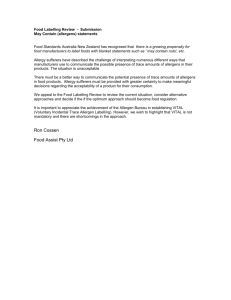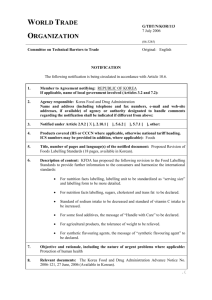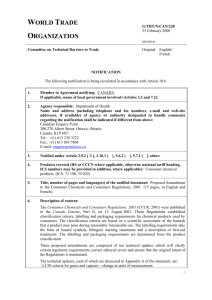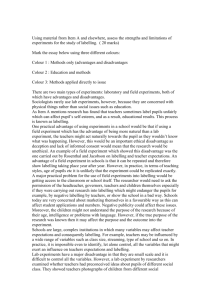Submission to the Australia and New Zealand Food Regulation
advertisement
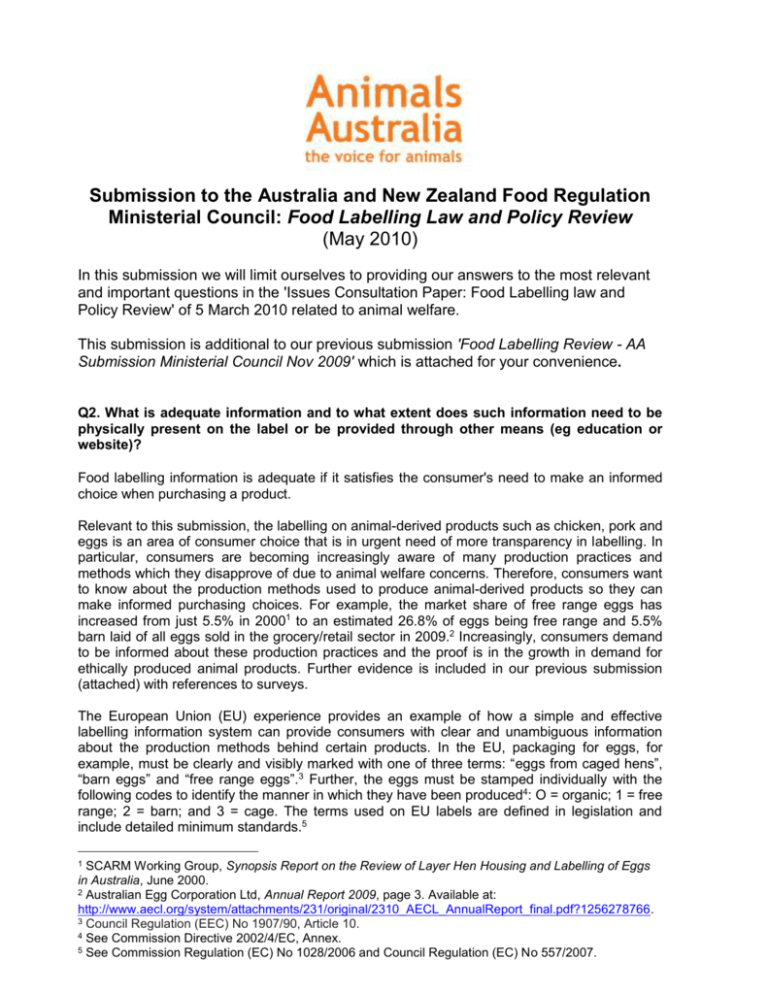
Submission to the Australia and New Zealand Food Regulation Ministerial Council: Food Labelling Law and Policy Review (May 2010) In this submission we will limit ourselves to providing our answers to the most relevant and important questions in the 'Issues Consultation Paper: Food Labelling law and Policy Review' of 5 March 2010 related to animal welfare. This submission is additional to our previous submission 'Food Labelling Review - AA Submission Ministerial Council Nov 2009' which is attached for your convenience. Q2. What is adequate information and to what extent does such information need to be physically present on the label or be provided through other means (eg education or website)? Food labelling information is adequate if it satisfies the consumer's need to make an informed choice when purchasing a product. Relevant to this submission, the labelling on animal-derived products such as chicken, pork and eggs is an area of consumer choice that is in urgent need of more transparency in labelling. In particular, consumers are becoming increasingly aware of many production practices and methods which they disapprove of due to animal welfare concerns. Therefore, consumers want to know about the production methods used to produce animal-derived products so they can make informed purchasing choices. For example, the market share of free range eggs has increased from just 5.5% in 20001 to an estimated 26.8% of eggs being free range and 5.5% barn laid of all eggs sold in the grocery/retail sector in 2009.2 Increasingly, consumers demand to be informed about these production practices and the proof is in the growth in demand for ethically produced animal products. Further evidence is included in our previous submission (attached) with references to surveys. The European Union (EU) experience provides an example of how a simple and effective labelling information system can provide consumers with clear and unambiguous information about the production methods behind certain products. In the EU, packaging for eggs, for example, must be clearly and visibly marked with one of three terms: “eggs from caged hens”, “barn eggs” and “free range eggs”.3 Further, the eggs must be stamped individually with the following codes to identify the manner in which they have been produced4: O = organic; 1 = free range; 2 = barn; and 3 = cage. The terms used on EU labels are defined in legislation and include detailed minimum standards.5 1 SCARM Working Group, Synopsis Report on the Review of Layer Hen Housing and Labelling of Eggs in Australia, June 2000. 2 Australian Egg Corporation Ltd, Annual Report 2009, page 3. Available at: http://www.aecl.org/system/attachments/231/original/2310_AECL_AnnualReport_final.pdf?1256278766. 3 Council Regulation (EEC) No 1907/90, Article 10. 4 See Commission Directive 2002/4/EC, Annex. 5 See Commission Regulation (EC) No 1028/2006 and Council Regulation (EC) No 557/2007. Taking egg labelling as a continuing example, there is a labelling regime currently in place by the Australian Egg Corporation Limited (“AECL”) called the Egg Labelling Guide. The Guide stipulates that labels should contain the terms “cage eggs”, “barn laid eggs” or “free range eggs”.6 It is recommended that it should be a mandatory requirement to have these terms printed on all egg cartons in Australia and New Zealand. The terms must be printed in a prescribed font type and size on the front of all egg cartons. Further, a legally defined description of the production system associated with that term should be included on the side of the packaging, again, in a prescribed font type and size. The description on the label should include the type of animal housing system used. Further information about these defined labelling terms should be made available on the websites of such organisations as the Australian Competition and Consumer Commission (“ACCC”) and Food Standards Australia and New Zealand (“FSANZ”). Similar trends in which consumers are increasingly wanting to buy more ethically produced free-range or organic meat products warrant the implementation of analogous labelling systems and legally defined terms. In the same vein, certain misleading information and images should not be present on the labelling of animal products. For example, terminology such as “Farm Fresh”, “Happy Hens”, and “Natural Grain” and images of green fields and hens perching in the sun are misleading and confusing to consumers. Such terminology and imagery implies that the animal was not raised using intensive (factory) farming practices and results in the consumer being confused and misled. Q3. How can accurate and consistent labelling be ensured? A national legally-defined and legally enforceable labelling regime would ensure accurate and consistent labelling. The labelling regime currently in place by the AECL – the Egg Labelling Guide – represents 90% of all Australian egg producers7, however this labelling scheme does not have a legislative backing. To add further ambiguity and a lack of centralised definitions, other organisations such as the Free Range Egg and Poultry Association of Australia (FREPAA) and the RSPCA have also developed their own set of labelling standards when it comes to the labelling of animal products. The result here is that the “free range” production system represents a wide continuum of terms, references, and animal welfare standards, and consequently much confusion amongst consumers. A national legislated labelling system should provide a set of legally defined terms and minimum standards that must be used on the labels of animal products. The legislative terms must specifically define the different production methods that are represented by the labelling terms and must contain minimum standards in relation to how the animals are housed, the farming methods used and other matters such as the transport and, where appropriate, the slaughter of the animals. 6 AECL, Egg Labelling Guide: Guide to Australian Laws, Regulations and Standards for Egg Producers, March 2009. 7 AECL, Quality Assurance (2009). Available at: http://www.aecl.org/egg-corp-assured> at 26 April 2010. The advantage of national, legal definitions of animal production systems is that these definitions can then be used by an auditing body independent from industry to audit compliance and as enforcement standards against producers who falsely label their products. Also, consumers can take comfort in the knowledge that the labelling representations they are provided with are accurate and legally defined which will empower them to make solidly informed choices. The ACCC alone does not have the resources to police and monitor compliance with a national food labelling standard. A collaborative model between the ACCC and FSANZ, however, could provide an effective enforcement process. This collaborative model would draw on an existing infrastructure between the ACCC and FSANZ; namely, the memorandum of understanding to facilitate cooperation and coordination between the ACCC and FSANZ, which was signed on 21 September 2009.8 This MOU provides a framework for cooperation when issues of responsibility overlap and, more importantly, will allow both agencies to take advantage of opportunities to assist each other with food regulatory and trade practices compliance activities.9 Similar national legally-defined and legally enforceable labelling regimes are appropriate for other animal-derived products. Q4. What principles should guide decisions about government intervention on food labelling? First and foremost, the right to make an informed choice as a consumer should be a fundamental principle when it comes to government intervention on food labelling. Further, stamping out misleading and deceptive conduct by producers should also be a driving principle to both ensure that consumers can rely on the information provided and to ensure that producers don't face unfair competition from producers that mislabel their products. The current abundance of confusing labelling has opened the door to many labelling scandals. For example, a recent study found that “from January 2006 to January 2007 the free-range flock would have had to grow by more than 37 per cent to match the increased sale of freerange eggs in the grocery sector… [t]he total free-range flock would have had to grow from 891,000 hens to 1.22 million to meet the free-range sales figures.”10 This means that as many as one in every six eggs labelled as “free range” are most likely false, or at least misleading based on common consumer understanding regarding the term “free range”. 8 Memorandum of Understanding between Food Standards Australia New Zealand and the Australian Competition and Consumer Commission (2009) http://www.accc.gov.au/content/item.phtml?itemId =525074&nodeId=90200c061feea6087d7643626e7fc677&fn=ACCC%20FSANZ%20MoU%20signed% 2029%20April%202004.pdf, 29 April 2010. 9 Australian Competition and Consumer Commission, Regulators Cooperate to Improve Food Regulation (Press Release, 29 April 2004). 10 Kelly Burke, ‘Egg Group Figures Run Foul of Free-Range Claims’, WA Today (WA), 5 September 2009; <http://www.watoday.com.au/national/egg-group-figures-run-foul-of-freerange-claims-20090906fcla.html>; Kelly Burke, ‘Free-Range Egg Claims Don’t Add Up’, The Sydney Morning Herald (NSW), 6 September 2009 <http://www.smh.com.au/national/freerange-egg-claims-dont-add-up-20090905fc4b.html>. In 2007 the Federal Court of Australia found one egg supplier guilty of substituting non-organic eggs for supposedly certified organic ones.11 The animal food industry labelling scams are giving rise to much misleading and deceptive conduct by producers clearly proving a failure of industry to self-regulate. Government intervention is critical if the rights of consumers to make informed choices are to be protected and loss of trust in food labelling in general is to be prevented. Another principle that should guide decisions about government intervention when it comes to food labelling is the regulation of market competition and fair trade. Such deceptive behaviour by some producers is also compromising a fair competitive playing field for Australian businesses. Producers of products that conform to higher welfare standards are being pressured financially and may be pushed out of the market due to the fraudulent activity of larger producers who subscribe to intensive farming practices and are therefore able to offer lower pricing due to economies of scale, and yet fraudulently pass their products off as “free range”. Q13.To what extent should the labelling requirements of the Food Standards Code address additional consumer-related concerns, with no immediate public health and safety impact? AND Q14.What criteria should be used to determine the inclusion of specific types of information? As an extension to our submission in Question 4 above, we make the following point: the criteria used to determine what kind of information should be included in labelling should be fundamentally driven by consumer demand. Consumers are calling out for labelling that clearly informs them about the production methods used to produce animal-derived products. Animal welfare is an important issue for Australians, demonstrated through community polls and politically recently through the establishment of the Australian Animal Welfare Strategy and its ongoing funding by the federal government. That Australians care about animal welfare is reflected in the results of a survey conducted for the pig and egg industry by Professor Grahame Coleman of Monash University. 60% of respondents agreed with the statement that “welfare of animals is a major concern”, while 71% agreed that “farm animal welfare is an important consideration”12. In relation to food, interest in animal welfare is evidenced by the increasing number of people that are becoming concerned about cruel practices inflicted on the large numbers of animals which are 'factory-farmed'. This concern is expressed through the growing demand for more ethically produced products such as free range eggs and free range and organic meat products. For example, the market share of free range eggs has increased from just 5.5% in 200013 to an estimated 26.8% of eggs being free range and 5.5% barn laid of all eggs sold in the grocery/retail sector in 200914. A specific example of growth was published in the 2009 11 Australian Competition and Consumer Commission v GO Drew Pty Ltd [2007] FCA 1246; Australian Competition and Consumer Commission, G O Drew Pty Ltd (2009) <http://www.accc.gov.au/content/ index.phtml/itemId/798723> at 25 April 2010. 12 See G Coleman, Public perceptions of animal pain and animal welfare in Australian Animal Welfare Strategy Science Summit on Pain and Pain Management, May 2007 – Proceedings. Available at: http://www.daff.gov.au/_data/assets/pdf_file/0006/299103/grahame-coleman.pdf. 13 SCARM Working Group, Synopsis Report on the Review of Layer Hen Housing and Labelling of Eggs in Australia, June 2000. 14 Australian Egg Corporation Ltd, Annual Report 2009, page 3. Available at: Woolworths Corporate Responsibility Report showing sales figures for the previous 12 months; free range chicken has increased 33.6%, and free range egg sales up 32%. As indicated by the growth in free range eggs sales, free range chicken and pork sales (advice to Animals Australia from Woolworths and Coles supermarkets), increasing numbers of consumers are willing to pay extra for more ethically produced food. Despite the current economical downturn, 95% of consumers in a recent survey stated they are prepared to do so15. Further evidence was documented in a 2007 report to show that the Australian consumer is willing to pay more for “cruelty-free” meat products16. Another indicator of consumer “willingness to pay” is the fact that some producers and retailers of animal food products are prepared to mislabel their products as “free range” or “organic” (and thereby break the law), in order to be able to charge the higher prices commanded by those products17. Q15.What criteria should determine which, if any, foods are required to have country of origin labelling? The leading criteria driver should be ensuring consumers are able to make informed choices when buying products that are made overseas. It has already been submitted that consumers perceive animal welfare as an important issue when purchasing animal-derived products. As such, CoOL should be present on all animal-derived products to indicate whether these products conform to those welfare standards that are legally defined and enforced domestically under the labelling systems proposed in this submission. Under the EU regime, eggs imported from non-EU countries must be packaged in cartons that are labelled with the eggs’ country of origin, as well as the phrase “non-EC Standards”. 18 A similar labelling standard could be implemented in Australia and NZ for those egg products that are imported from abroad as well as other imported animal-derived products. Already ACT law requires egg cartons to be labelled indicating the housing method used, ensuring both ACT produced eggs and interstate eggs are labelled. Q17.Is there a need to establish agreed definitions of terms such as 'natural', 'lite', 'organic', 'free range', 'virgin' (as regards olive oil), 'kosher' or 'halal'? If so, should these definitions be included or referenced in the Food Standards Code? From a consumer perspective, there is a great need to establish agreed definitions of terms for animal-derived products such as meat and eggs. Recently it has been shown that consumers are at times misled to believe they are buying 'free-range' products while the product in reality wasn't produced according to what generally is believed to be 'free-range'. An example of this is the current widespread use of the words 'Free to Roam' on chicken meat from factory farmed chickens. These chickens are permitted to be housed wholly in sheds at up to 20 chickens per square metres and can rarely move more than a few metres to feed and water in the crowded sheds. http://www.aecl.org/system/attachments/231/original/2310_AECL_AnnualReport_final.pdf?1256278766. 15 Humane Society International Australia, 2009 National Consumer Survey, November 2009. 16 See Voiceless, summary of survey results in From Label to Liable: Scams, Scandals and Secrecy, 2007. 17 See for example ACCC v GO Drew Pty Ltd [2007] FCA 1246. 18 Council Regulation 2001/05/EC of 19 December 2000 amending Article 7 of Regulation 1907/90/EEC. Lack of legally defined terms however makes it very difficult to prevent this misleading conduct. Agreed, legally defined definitions therefore are essential for consumers to be able to make informed choices to their preferences and to be able to rely on the information provided. Legally defined definitions are also important for producers to have clear guidance on what criteria they have to adhere to if they want to market their product as an added value product. Furthermore, established definitions are essential for proper auditing and for enforcing compliance. Recent complaints have shown that the lack of established legal definitions makes it virtually impossible to force producers to withdraw their misleading claims. These definitions should be referenced in the Food Standards Code. Q18. What criteria should be used to determine the legitimacy of such information claims for the food label? See response to Q3 above. In addition, livestock farming 'commercial' quality assurance audit systems should require adherence to legally defined label terminology, and current and future Government-backed monitoring of (particularly) factory farming systems must incorporate assessment of compliance with labelling descriptions of all animal-derived products. Q29.In what ways can consistency across Australia and New Zealand in the interpretation and administration of food labelling standards be improved? AND Q30.In what ways can consistency, especially within Australia, in the enforcement of food labelling standards be improved? The only way to ensure consistency in food labelling and its enforcement is by introducing legally defined terms with clear descriptions of the related minimum standards and by having independent auditing by a central body (backed by consistent commercial and government audit systems). The adoption of the submission made in Question 3 above should ensure a consistent approach to the interpretation and administration of food labelling standards. Submission ends. Animals Australia 13 May 2010.

